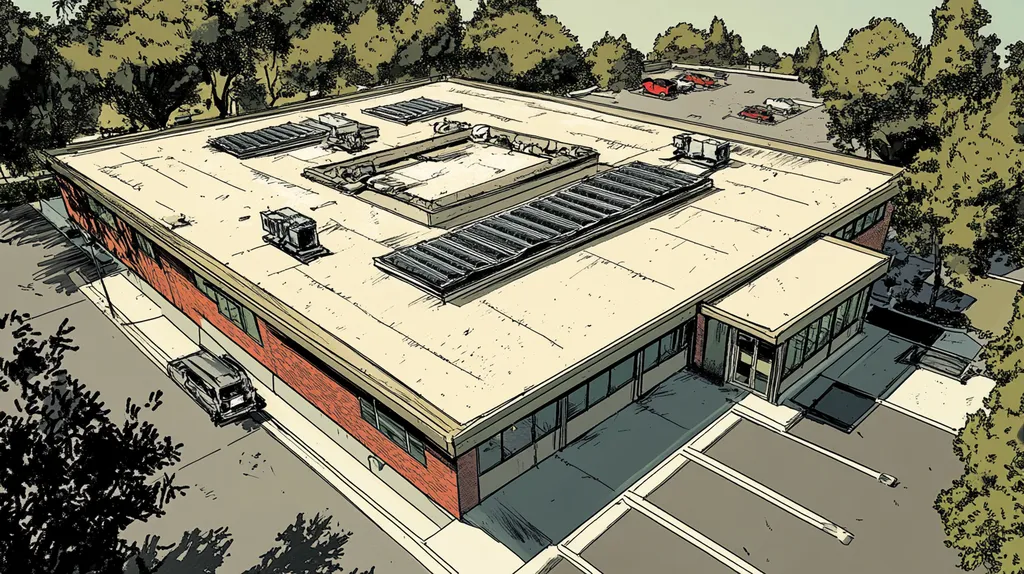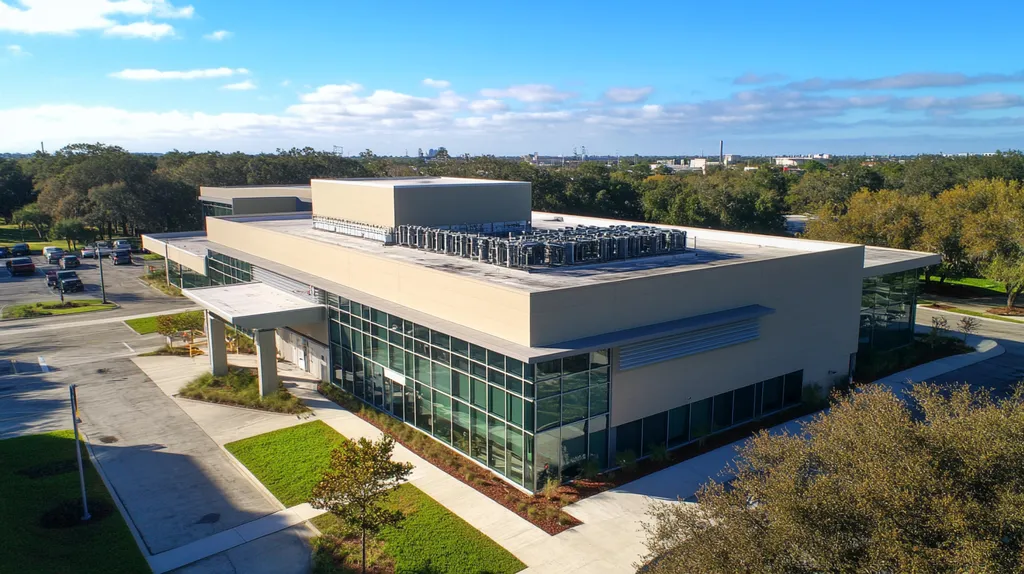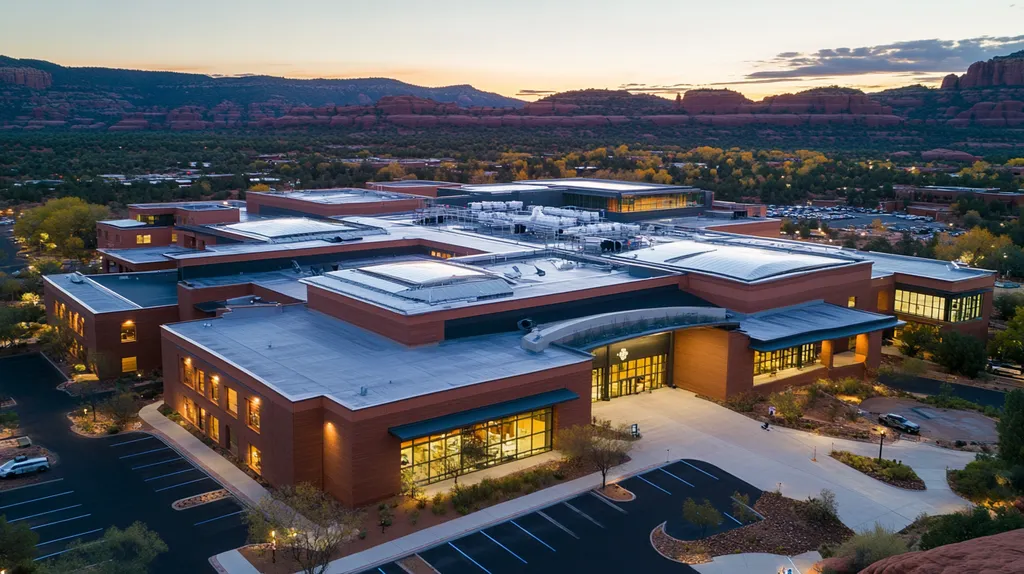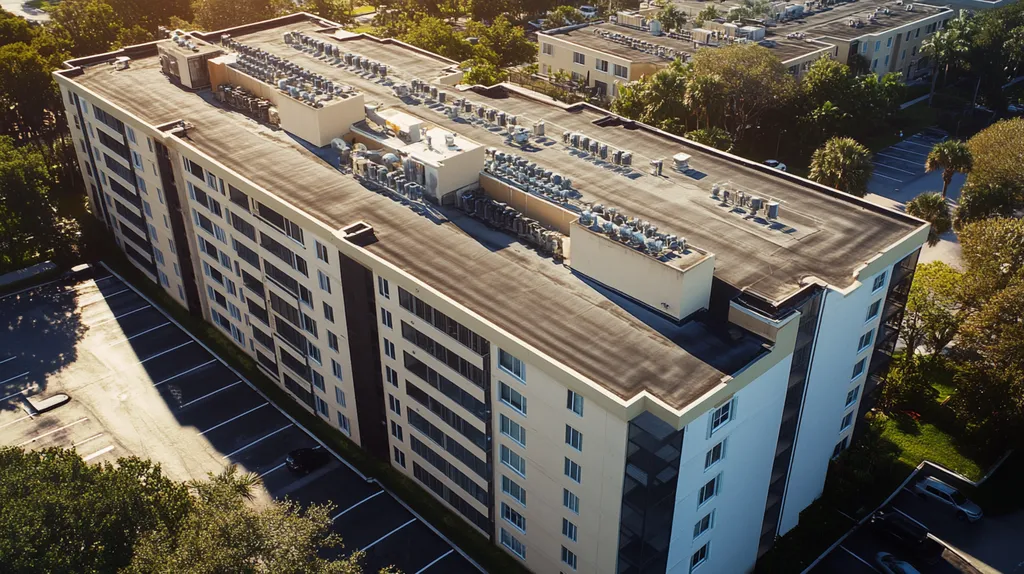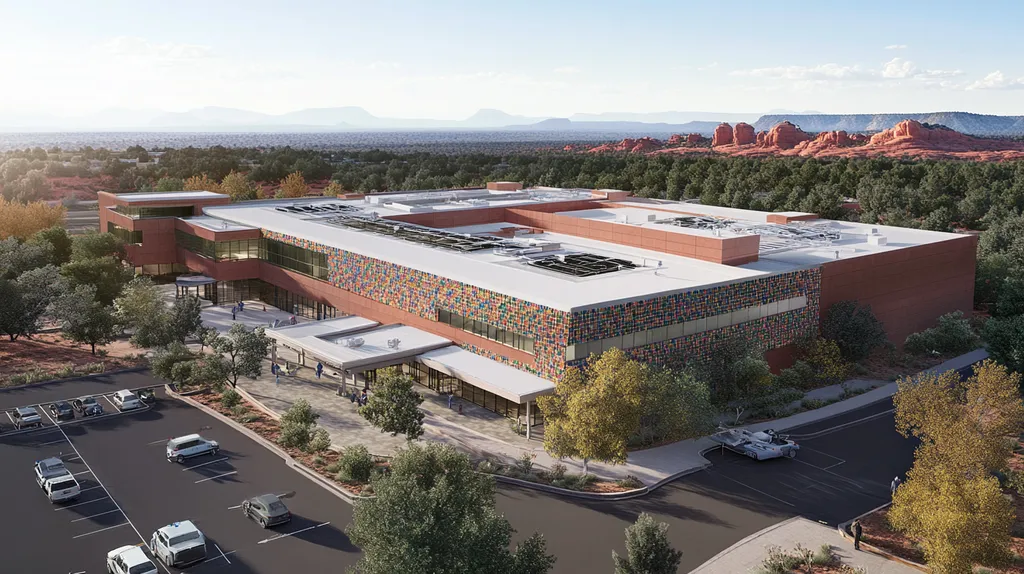Every year, over 50 commercial facilities face catastrophic roof failures due to safety regulation violations, resulting in millions in damages and dozens of preventable injuries. For facility managers, ensuring roofing safety compliance isn’t just about following rules—it’s about protecting lives and assets.
This comprehensive guide provides facility managers with actionable solutions for maintaining roof safety standards across six critical areas: performance factors, financial planning, compliance requirements, risk management, operational procedures, and long-term considerations.
By following these evidence-based protocols and industry-tested practices, managers can create safer roofing environments while reducing liability exposure and maintenance costs.
SECTION 1: PERFORMANCE FACTORS
Commercial roofs endure constant pressure from weather elements and operational activities, which can create serious safety risks. Alarmingly, about 30% of commercial roof failures stem from mechanical or structural problems. For facility managers, understanding the common issues in roof maintenance is vital for avoiding expensive repairs and ensuring safety compliance. This section explores critical performance factors that affect roof integrity, concentrating on mechanical and structural failures, assessing roof material reliability, and effective drainage management.
Common Mechanical and Structural Failures
Mechanical and structural failures rank among the top reasons for roof damage in commercial properties. While roofs are engineered to handle substantial loads, faulty installations or lack of maintenance can have disastrous effects. For instance, worn-out fasteners can cause the roof membrane to peel away, putting the entire structure at risk.
Another frequent issue is inadequate reinforcement of support structures. Many roofs do not comply with current load-bearing regulations, resulting in premature failures when subjected to stress. Regularly inspecting the supporting structures can help facility managers identify vulnerabilities before they worsen.
Weather-related strains also play a role in mechanical failures. Forces like wind uplift and thermal expansion can threaten roof systems, eventually leading to leaks and structural harm. Being proactive in addressing these stressors is crucial for maintaining the roof’s performance and overall safety.
Key Action Items
Assessing Roof Material Integrity
The longevity of a commercial roof heavily relies on the integrity of its materials. Over time, exposure to UV rays, temperature fluctuations, and environmental contaminants can weaken materials, making them susceptible to damage. For example, single-ply membranes may become brittle over the years, losing their ability to repel water effectively.
Conducting regular assessments of the roof’s condition is essential for spotting signs of wear. Indicators such as cracks, blisters, or visible rust are signals for a closer examination or replacement. Facility managers should maintain detailed records of the roof’s material condition to make informed maintenance decisions.
Moreover, selecting the right materials is crucial. Certain materials demonstrate better durability against specific environmental conditions. By understanding the features of available roofing options, managers can make educated choices that enhance the roof’s resilience.
Key Action Items
Evaluating Drainage and Moisture Management
Proper drainage and moisture management are critical for safeguarding commercial roofs from damage. Standing water can create ponding, increasing weight and elevating the risk of structural failure. Poor drainage is responsible for an estimated 15% of all roof failures.
Routine inspections of drainage systems, including gutters and downspouts, are key to preventing moisture-related challenges. Facility managers should look for clogs or signs of wear that can hinder water flow.
Additionally, the roof’s slope and design play essential roles in effective moisture management. Proper sloping ensures water flows to designated drainage points. A thorough evaluation of the roof’s design can reveal potential issues that might lead to problems down the road.
Key Action Items
SECTION 2: FINANCIAL CONSIDERATIONS
The financial stakes surrounding commercial roofing are high, particularly when safety regulations are overlooked. Ignoring these can lead to significant liabilities, which are costly and can jeopardize the entire business. With 33% of construction-related fatalities due to falls from roofs, understanding financial implications for roof safety is paramount. This section will guide facility managers through budgeting for safety upgrades, analyzing the cost-effectiveness of preventive maintenance, and evaluating liability and insurance impacts.
Budgeting for Safety Upgrades and Repairs
Effective budgeting for safety upgrades and repairs is crucial for facility managers to remain compliant with safety standards. Proactive safety inspections can catch potential hazards early, allowing for better financial planning. Without effective budgeting, unexpected repair costs can arise, putting both the roof and employee safety at risk.
Allocating a specific portion of the budget for safety upgrades, such as guardrails and safety harnesses, empowers property owners to invest in safety measures that extend their roof’s lifespan and reduce liability. These improvements not only mitigate risks but can also enhance the overall functionality and durability of the roofing system.
Facility managers should also consider environmental factors, like seasonal weather changes, when planning budget allocations. Extreme weather can lead to sudden damages that necessitate costly emergency repairs. By planning ahead, managers can balance their budgets and safeguard against these unexpected expenses.
Key Action Items
Cost-Benefit Analysis of Preventive Maintenance
Performing a cost-benefit analysis on preventive maintenance can offer compelling insights into financial prudence for roof safety. Regular maintenance is proven to reduce major repair incidents by up to 70%, ultimately saving facility managers a substantial amount of money in the long run. Investing in a solid maintenance plan is not just an expense; it’s a smart strategy that leads to fewer costly repairs and minimal disruptions.
A proactive approach also means spotting minor issues before they spiral into major problems, which can lead to emergency repairs that carry hefty costs. For example, neglecting a small leak can result in extensive water damage and an entire roof replacement, causing significant financial strain.
Furthermore, facilities that prioritize preventive maintenance often experience enhanced energy efficiency, leading to lower utility costs. A well-maintained roof provides better insulation, directly affecting overhead expenses and boosting the company’s bottom line.
Key Action Items
Estimating Liability and Insurance Implications
Evaluating potential liability stemming from roof safety violations is vital for effective risk management. Non-compliance can result in serious accidents, leading to lawsuits that can harm the organization’s financial health. By understanding these risks, facility managers are encouraged to uphold safety protocols and minimize legal exposure.
The safety record of a facility directly impacts insurance premiums. A history of claims related to roof safety can lead to rising costs, emphasizing the need for strict adherence to safety measures. Conversely, a solid safety record can qualify facilities for discounts, relieving some of the financial burden.
Regular review of insurance policies is essential to ensure that coverage adequately protects against incidents related to roof safety. Policies can vary significantly, and thorough inspections often reveal gaps in coverage that could expose a facility to financial risks.
Key Action Items
SECTION 3: COMPLIANCE REQUIREMENTS
Meeting roofing safety regulations is not just important for legal reasons; it plays a vital role in managing risks for facility managers. With over 100 fatal falls from roofs reported annually, the stakes couldn’t be higher. Neglecting compliance can lead to not only severe financial penalties but also put employee safety at significant risk. This section will outline essential compliance requirements, focusing on OSHA standards, local regulations, and the crucial need for accurate documentation.
Understanding OSHA Roofing Safety Standards
The Occupational Safety and Health Administration (OSHA) mandates strict safety standards for roofing operations. These guidelines require fall protection systems to be in place and mandate training for all employees involved in roofing work. For instance, any staff working at heights over six feet must use fall protection measures. Failing to comply can result in substantial fines and serious injuries or fatalities.
Facility managers should conduct regular safety audits to ensure their teams follow OSHA guidelines. Implementing simple safety measures, like guardrails and personal fall arrest systems, can make a considerable difference. Regular training sessions are equally important, as they keep employees updated on the latest safety practices and equipment.
It’s essential to stay informed about changes to OSHA regulations, as they can shift frequently. Facility managers must remain vigilant to ensure compliance, which is crucial for creating a safe working environment.
Key Action Items
Navigating Local Building Codes and Regulations
In addition to OSHA regulations, local building codes add another layer of compliance that facility managers must understand. These codes differ widely by jurisdiction and enforce standards for materials, construction, and overall safety. For instance, specific regions may require roofing materials that can withstand local weather conditions, such as heavy snow loads or high winds.
Familiarizing oneself with applicable local codes is crucial for facility managers. A lack of understanding can lead to non-compliance, expensive renovations, or even legal trouble. Connecting with local building authorities early in any planning process can help clarify what is required.
Many cities provide resources to aid property owners in navigating these codes. It’s also important to regularly review and update roofing plans to meet any new building regulations, ensuring compliance and safety.
Key Action Items
Documentation and Reporting for Regulatory Compliance
Maintaining thorough documentation and accurate reports is essential for staying compliant with roofing safety regulations. Keeping detailed records of safety training, inspections, and maintenance acts as vital evidence during inspections or audits. For example, tracking dates, topics, and attendees of training sessions illustrates a commitment to employee safety.
Moreover, facility managers should implement a sound reporting system for any accidents or near misses on the roof. These reports can illuminate safety hazards and help refine training programs. They also ensure transparency with regulatory agencies.
Regularly reviewing compliance documentation helps ensure all records are up to date and easily accessible, which can prevent serious ramifications if compliance issues arise. A well-organized compliance file can also facilitate smoother inspections from regulatory bodies.
Key Action Items
SECTION 4: RISK MANAGEMENT
Ensuring roof safety goes beyond simple guidelines; it’s a critical responsibility. Falls contribute to roughly 33% of construction fatalities, as per OSHA statistics. For facility managers, mastering risk management for roof safety is not just about compliance—it’s about preserving lives and protecting the company from financial setbacks. This section details vital strategies to recognize, address, and respond to potential hazards on commercial roofs.
Identifying and Mitigating Fall Hazards
The first step in risk management is to identify fall hazards on commercial roofs. Common risks include unguarded edges, roof openings, and unstable surfaces. Facility managers need to perform consistent inspections to pinpoint these hazards and evaluate their severity. Simple interventions, such as installing guardrails or warning alerts, can significantly lessen the chances of falls.
Alongside routine inspections, training employees to recognize and report potential fall hazards is vital. Signage reminding staff of dangers can strengthen a culture of safety, effectively blending awareness with physical solutions to enhance overall site safety.
Regular maintenance checks play a critical role as well. Weather-related wear and tear can intensify existing hazards over time, making it essential for facility managers to schedule frequent evaluations to manage risks proactively.
Key Action Items
Implementing Personal Protective Equipment Protocols
Establishing proper personal protective equipment (PPE) protocols is essential for safeguarding workers on roofs. This framework includes comprehensive training on using safety gear, such as helmets and harnesses. Proper usage of PPE minimizes exposure to risks and is fundamental to a safe work environment.
Organizations must develop strict PPE protocols and enforce them consistently. For example, requiring safety harnesses when near edges can greatly decrease the likelihood of falls. Regular training sessions reinforce the importance of these safety measures.
Ensuring that all PPE is suitable and well-maintained is also crucial. Routine inspections of equipment should be scheduled to prevent failures during critical moments. Promoting a strong safety culture encourages compliance, building trust among workers and enhancing productivity.
Key Action Items
Emergency Preparedness and Incident Response Plans
Preparedness for emergencies is a vital element of risk management in commercial roofing. A well-defined incident response plan is essential to address accidents swiftly and efficiently. This plan should outline specific procedures to follow during a fall or other emergencies.
Facility managers should conduct regular drills to ensure every employee understands their role in an emergency situation. Familiarizing the team with evacuation routes and first aid practices can make a difference when time is critical. Continuous training should adapt to changes in job site conditions or equipment.
Clear communication channels are also critical. All employees need to know how to report incidents and whom to contact, facilitating faster responses and accurate tracking of incidents for documentation and compliance.
Key Action Items
SECTION 5: OPERATIONAL PROCEDURES
Prioritizing operational procedures for roof safety is essential for protecting personnel and property from hazards. With falls from heights contributing significantly to workplace injuries, implementing organized and efficient protocols can greatly reduce these risks. This section will highlight critical practices for establishing safe roof access, coordinating onsite activities, and scheduling routine maintenance, all aimed at maintaining secure and functional roofing systems.
Establishing Safe Roof Access and Egress
Designing a secure pathway for roof access is vital for minimizing accidents. Facilities should install permanent ladders or stairways for safe entry and exit while defining clear routes to reduce the likelihood of slips and falls.
Signage also plays a crucial role in alerting personnel to potential hazards. Clear guides on where to walk and where to avoid will enhance safety awareness, ensuring everyone is mindful of their surroundings.
Additionally, personal protective equipment (PPE), such as harnesses, should be mandatory when working at heights. Regular training will help ensure that all workers know how to use this equipment correctly to protect themselves.
Moreover, installing safety barriers around the roof’s edge can prevent accidental falls and further bolster safety protocols.
Key Action Items
Coordination of Onsite Contractors and Activities
Fostering effective communication among contractors is essential for a safe roofing environment. Careful scheduling during transitions between different contractors can prevent overlaps, mitigating misunderstandings and unsafe conditions.
Daily safety briefings are crucial for aligning team members on ongoing tasks and potential risks. These meetings should specifically address roofing hazards, ensuring everyone is aware and prepared for their responsibilities.
Designating a safety officer can enhance coordination efforts, as this individual would enforce safety protocols and address any immediate safety concerns.
Conducting regular audits of contractor performance and safety practices reinforces accountability and helps identify any unsafe behaviors that may arise.
Key Action Items
Routine Roof Inspection and Maintenance Scheduling
Conducting regular inspections is critical for preventing roof damage and ensuring safety. Scheduling inspections helps identify vulnerabilities before they escalate into serious problems. Industry standards recommend inspecting roofs at least twice a year, ideally in spring and fall.
Facility managers should look for signs of wear or damage, such as leaks or loosened flashing, during these inspections. Promptly addressing these issues extends the roof’s lifespan and maintains safety.
Developing a comprehensive maintenance schedule is equally essential. This plan should detail necessary repairs, cleaning routines, and equipment checks to keep the roof in optimal condition.
Utilizing technology, like drones for inspections, can significantly improve the efficiency of this process, enabling quick surveys of large areas to identify issues that may not be visible from the ground.
Key Action Items
SECTION 5: OPERATIONAL PROCEDURES
Prioritizing operational procedures for roof safety is essential for protecting personnel and property from hazards. Falls from heights contribute significantly to workplace injuries, making organized protocols vital in mitigating these risks. This section will highlight critical practices for establishing safe roof access, coordinating onsite activities, and scheduling routine maintenance to keep roofs secure and functional.
Establishing Safe Roof Access and Egress
Creating a secure pathway for roof access is fundamental for minimizing accidents. Facilities should install permanent ladders or stairways to enable safe entry and exit. Clearly defined routes help reduce the risk of slips and falls.
In addition to physical access points, effective signage is crucial in notifying personnel about potential hazards. Clear instructions regarding where to walk and areas to avoid will promote safety awareness on site.
Personal protective equipment (PPE), such as harnesses, must be mandatory when working at heights. Regular training can ensure that all workers are proficient in using this equipment correctly for their protection.
Furthermore, installing safety barriers around the roof’s edge can help prevent accidental falls, reinforcing safety protocols significantly.
Key Action Items
Coordination of Onsite Contractors and Activities
Effective communication among contractors is crucial for a secure roofing environment. Transitioning between different contractors requires careful scheduling to prevent overlap, which can lead to misunderstandings and unsafe conditions.
Daily safety briefings can be invaluable for aligning team members on ongoing tasks and associated risks. These meetings should specifically address roofing hazards and ensure everyone understands their roles and responsibilities.
Designating a safety officer can further improve coordination efforts. This person will be responsible for enforcing safety regulations and responding to any immediate safety concerns that may arise.
Conducting regular audits of contractor performance and safety practices enhances accountability while helping to identify and correct any unsafe behaviors on-site.
Key Action Items
Routine Roof Inspection and Maintenance Scheduling
Regular inspections are key to preventing roof damage and ensuring safety. Scheduled inspections help spot vulnerabilities before they escalate into significant problems. Industry standards recommend inspecting roofs at least twice a year, ideally in spring and fall.
During these inspections, facility managers should look for signs of wear or damage, such as leaks or loose flashing. Addressing these issues promptly extends the roof’s lifespan and maintains safety.
Developing a comprehensive maintenance schedule is equally important. This plan should outline necessary repairs, cleaning routines, and equipment checks to keep the roof in optimal condition.
Utilizing technology, like drones for inspections, can enhance the efficiency of this process. Drones can quickly survey large areas, helping to detect issues that may not be visible from the ground.
Key Action Items
The Bottom Line
With over 50 commercial roof failures annually and millions in damages at stake, implementing comprehensive safety protocols isn’t optional—it’s imperative for facility survival.
This guide demonstrates that successful roof safety compliance requires a systematic approach across six critical domains: performance monitoring, financial planning, regulatory adherence, risk management, operational procedures, and long-term strategic planning.
By following these evidence-based protocols and industry-tested practices, facility managers can reduce liability exposure by up to 70% while extending roof lifespans by 5-10 years.
The time to act is now: every day without proper safety measures increases risk exposure and potential costs.
Remember: when it comes to commercial roof safety, prevention isn’t just better than cure—it’s essential for business continuity.
FREQUENTLY ASKED QUESTIONS
Q. What are common mechanical issues with a commercial roof?
A. Common mechanical issues include worn-out fasteners and inadequate support structures. Faulty installations can also result in leaks, jeopardizing safety and increasing repair costs. Regular inspections help identify these vulnerabilities, ensuring proper maintenance and preventing serious damage.
Q. How should I budget for roof safety upgrades?
A. Budgeting should involve allocating a specific amount for safety upgrades, including guardrails and harnesses. Regular inspections can help identify hazards early, allowing for planned expenses. Proper planning helps manage seasonal impacts and reduces unforeseen repair costs.
Q. What are OSHA standards for a commercial roof?
A. OSHA standards require fall protection systems for employees working at heights above six feet. Regular audits and training are essential for compliance. Implementing safety measures like guardrails and ensuring all employees are trained on these regulations significantly enhances safety.
Q. How can I identify potential fall hazards on my commercial roof?
A. Identifying fall hazards involves consistent inspections for unguarded edges and unstable surfaces. Regular training helps staff recognize and report potential risks. Implementing proactive measures like guardrails and maintenance checks dramatically lowers the risk of falls.
Q. What should my routine roof inspection include?
A. Routine inspections should include checking for leaks, loose flashing, and any signs of wear. Scheduling these inspections in spring and fall helps address issues before they escalate. Documenting findings assists in planning necessary repairs and maintaining safety.
Q. How can contractors coordinate safely on a commercial roof?
A. Schedule regular safety briefings and designate a safety officer to oversee work. Clear communication and documentation of safety protocols are essential to prevent overlaps and ensure everyone is aware of their roles, which enhances overall safety.
Q. What types of personal protective equipment are necessary for a commercial roof?
A. Necessary personal protective equipment includes safety harnesses, helmets, and non-slip footwear. Regular training reinforces the correct usage of this gear. Maintaining equipment and ensuring compliance with PPE protocols significantly increases worker safety on roofs.

